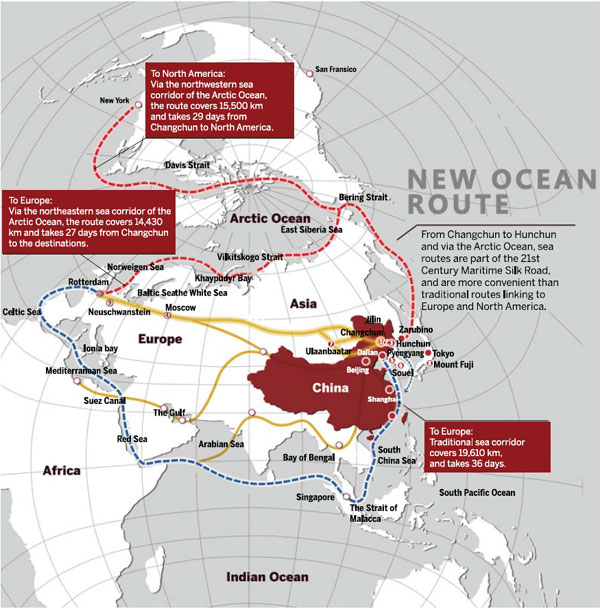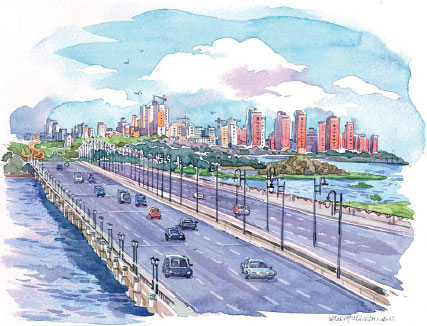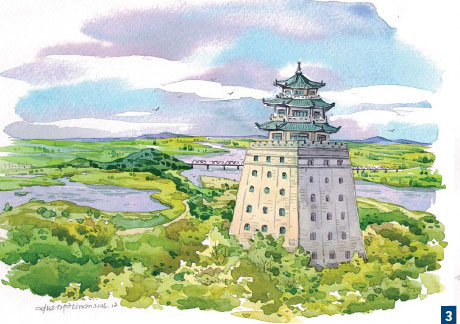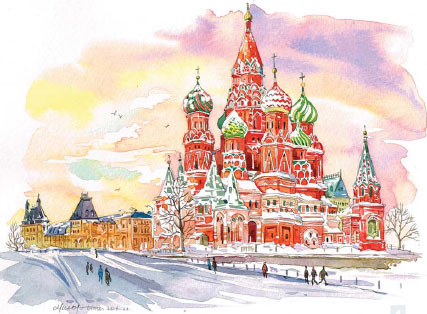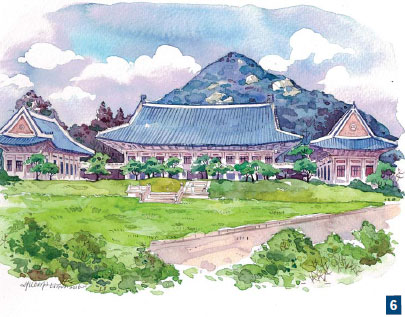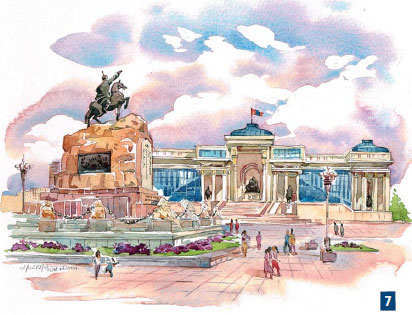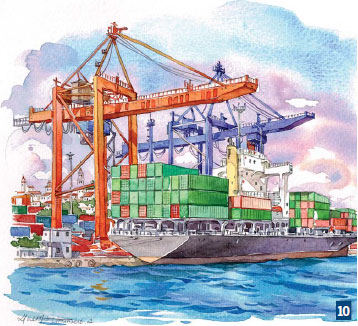Technology And Geography Unite To Fuel Growth
Changchun New Area has mapped out a brilliant future: as a national-level new area, a free trade experimental area, and a key hub in China's opening-up to the world. It will play a pivotal role in implementing China's Belt and Road Initiative. Now the area has embarked on its journey to becoming
a powerhouse for the domestic economy and will spearhead the extension of China's global connections.
At an auto parts factory in Changchun, engineers stood in front of a desk with a small display screen hung on the wall. They touched the screen every now and then while dealing with the parts and containers. On the screen, information about the engineer and the parts, his or her working time, quantity of tasks and the amount of standard and substandard products is displayed. It is the intelligent factory management system, developed by Changchun E-Plus Technology, a Changchun-based startup founded in 2015 by a group of former senior managers of auto parts factories.
Wang Wenbo, assistant general manager of the company, said that in the past, managers had to gather workers every morning to distribute the workload, which felt like a waste of time.
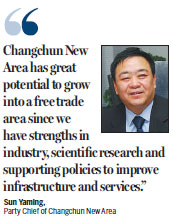
"We aim to revolutionize old methods and update our databases with a small screen and the internet," he said. "It will significantly improve efficiency, reduce the cost of management and save paper used to record all the information before."
The intelligent factory management system is the result of efforts to innovate the traditional industries of Changchun, capital of Northeast China's Jilin province.
The city is known as a base for top automobile brands like China FAW Group Corporation. It is also home to the 70-year-old Changchun Film Studio, Changbai Mountain and extreme cold, falling to minus 20 C in winter.
Last year saw Changchun step into a new development phase once the State Council approved construction of Changchun New Area in February, the 17th national new area since Shanghai's Pudong New Area was approved in 1992.
According to a statement published on the official website of the State Council on Feb 15 last year, the new area comprises four districts of Changchun with a planned area of 499 square kilometers, aiming to promote the Belt and Road Initiative and revitalize the economy of northeastern China.
Party Chief of Changchun New Area Sun Yaming said northeastern China is now confronted with an economic downturn.
"Though we have some traditional industries which are well-known throughout the country, the scale and clustering of the industries are limited," he said. "The transformation of the industrial structure is still a heavy task.
"These problems are common in northeastern Chinese cities, hampering economic growth."
Sun expects innovation to drive the new area's growth.
"Innovation should be emphasized not only in the development of industries, but also in business models, as well as city's construction and management mechanisms," he said. "The new area is an innovative platform. There is no need to follow any fixed mode."
He said they would use new technology to cultivate three of its major industries, including high-end manufacturing, modern agriculture and modern services.
"Changchun has a long history of producing and studying automobiles. We can apply state-of-the-art information technology to the production of automobiles," he said. "We can also use Internet Plus technology in the research and development of satellites, airplanes and robots to promote the high-end manufacturing industry," he said.
He said innovation in agriculture could also be boosted through introduction of international agricultural enterprises, including Sinobioway Group and Heilongjiang Beidahuang Agriculture Co, to develop higher-quality food and urban agriculture equipped with modern management and production mechanisms.
The city's scientific strength provides more opportunities for innovation. It has three national laboratories, 34 national parks and bases and many scientific institutes and universities, including Jilin University and the four institutes of the Chinese Academy of Sciences, fostering high-level professionals every year, he said.
China's first self-made high-resolution commercial satellite, the JILIN-1 Satellite, was launched in October, 2015 by Chang Guang Satellite Technology, located in Changchun New Area. It is the first satellite named after a province. The company was founded by Xuan Ming, former president of the Changchun Institute of Optics, Fine Mechanics and Physics, Chinese Academy of Sciences.
The statement by the State Council also indicated that Changchun New Area has a unique geographical position with great potential for businesses looking to go global.
Located in the center of Northeast Asia and the Bohai Bay Rim, Changchun has strong connections with Mongolia, Russia, Japan, the Republic of Korea and many European countries.
Sun said: "Northeast Asian countries are rich in resources and develop their economies quickly. We hope to promote trade with these countries."
Spearhead to the world
Sun said Changchun New Area aims to become a new window to the world by 2030.
The first step is to apply for the national new area based on its four high-tech zones, which was done in February last year. It will make the city a new free trade area in 2020. And by 2030, the economic policies should meet the demand of an international trade center.
"Changchun New Area has great potential to grow into a free trade area since we have strengths in industry, scientific research and supporting policies to improve infrastructure and services."
The new area now has 134 foreign companies and 25 companies invested in by Fortune Global 500 enterprises.
In 2016, a series of projects were settled in the area, bringing in a total investment of up to 10 billion yuan ($1.45 billion) for each, including Puren International Medical Town, Sinobioway Biological Agriculture Demonstration Zone and Guangdong Longhao Airport Industrial Park.
"The new area is attracting more projects, which will help to promote the construction of an industrial cluster of high-end manufacturing, bio-medicine and new material industries," Sun said.
International industrial parks co-constructed with Japan, the Republic of Korea, Germany and other European countries are under way with investment and high-end technology being introduced.
Also, 12 trade representative offices and 24 cargo-canvassing centers in cities such as Moscow, Paris, San Francisco and New York are expected to be established in 2030.
"We expect to turn 'processed in Changchun' into 'made in Changchun'," Sun said.
He said approval system has been simplified to attract more projects to come. "The time was reduced by 50 percent. Now, it takes only one month to introduce and begin a project in the new area."
Beyond the new projects and management mechanisms, logistics systems have also been improved through construction of international airports and land ports.
The new area launched the expansion project of Longjia International Airport in 2015 with more international routes expected to open, including Changchun-Russia flights and routes reaching cities in northern Europe, he said.
When the project is completed in 2017, the passenger volume will be increased to 60 million every year and cargo volume will reach 3 million tons per year, according to Sun. The figures are expected to hit 7 and 38 times of those in 2015 respectively.
"The airport will be the logistics hub of northeastern Asian airlines," he said.
The Changchun-Manzhouli-Germany international cargo train opened on Aug 31, taking just 14 days to travel through 13 railway stations in five European countries.
"With more international airlines, railways and ship routes to be opened, Changchun New Area will become the production and material reservation base in Northeast Asia which covers 28 countries with a population of 880 million and a gross economy of $30 trillion," Sun said.
To attract more international trade, Sun said the local government will build an international airport business district near the Longjia International Airport by 2020, which will house a convention center, reception center, exhibition center and foreign consulates.
He said they plan to build a first-class modern commercial center in Northeast Asia to serve foreigners who visit or seek business agreements in Changchun.
"Only if we target the global market can we have more access to modern technology, resources, markets, professionals and ideas in a broader international context," Sun said.
"Located in the center of Northeast China, Changchun New Area connects northeastern China's cities as a whole," he said. "Now many roads have been built, many projects have been introduced and many new policies have been released. Though we still face some problems, I believe the new area will play an important role in the revitalization of Northeast China."
Though he feels great pressure facing so many challenges, Sun said he is deeply moved when he sees how dedicated his colleagues are to the new area's growth.
"As for myself, this job brings me many challenges, but also brings many touching moments. Ever since the planning stages of Changchun New Area, we have received so much help and support from the superior departments. Employees in the new area are so passionate to participate," the 60-year-old Party chief, who has spent many years in different major district and development areas in the city, said. "I see a bright future for an innovative, inclusive, fair and ecologically friendly new area."
chenmeiling@chinadaily.com.cn
|
Benefiting from the Belt and Road Initiative, Changchun New Area's strong links to Asian and European countries have been boosted. Its trade with the above hub countries including (Picture 4 from left below) Russia, Democratic People's Republic of Korea, Republic of Korea, Mongolia, Japan, Germany and the Netherlands will be significantly strengthened. The train from Changchun to Germany takes only 14 days, covering 9,800 kilometers. The northern ocean route from Hunchun (Picture 3), a city close to Changchun, to Europe takes 27 days and southern route takes 36 days. |
|
|
|
|
|
|
|
Moscow, Russia |
|
|
|
|
|
Ulaanbaatar, Mongolia |
|
|
|
Neuschwanstein Castle, Germany |
|
Rotterdam, the Netherlands |
(China Daily 02/13/2017 page25)


